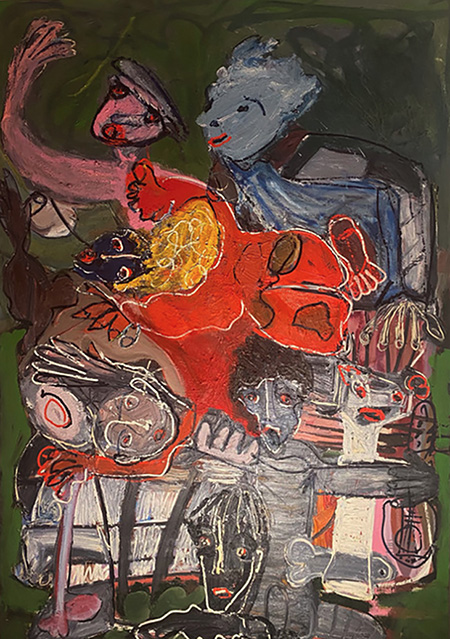
Tod Bailey’s large and exuberant paintings are populated by figures interacting ambiguously on the canvas. They are often packed together with a sense of urgency that exudes emotional and sexual energy. “Auto-de-Fe” is a jumble of figures seemingly engaged in an orgy of copulation. “Border Horror Show” dominates the gallery with 12 feet of violently fractured figures that references immigration abuses along the U.S. southern border, its visual rhetoric making us feel the need for reform. Executed primarily in black and white, it evokes both Picasso’s “Guernica” in its expression of suffering and Goya with its grasp of chaos. By contrast, “Loaded Silence,” all in shades blue, is a lyrical depiction of a nocturnal scene that feels like we are witnessing the central figure in the throes of a nightmare.
In “Death of Marat at the Drive-In,” the familiar bathtub encloses the reclining figure of French journalist and revolutionary Jean-Paul Marat, a hole blown above his right eye and an expression of surprise covering the rest of his face. The tiny figure of his killer, Charlotte Corday, appears as an angry rabbit floating in the center of the composition. The image stands in contrast to Jacque-Louis David’s classic version of the assassination. The calm repose of the sole figure, the solemnity and cool tones of the original are replaced by emotional heat turned up to the maximum. Where David’s backdrop of an unadorned wall served to monumentalize the fallen hero, Bailey’s golden candles and gravestones stand out against the blood red background that only intensifies the violence of the moment.
Bailey’s figures are rendered quickly with swipes of the brush and then enunciated with marks made by a stick or the handle of the brush. The surfaces are scumbled rather than buttery, making the impasto flatter than at first appears. Figures and objects mostly crowd the front of the picture plane. Bailey is unconcerned with depth of field, and his gestural technique is highly idiosyncratic. Even though he does sketches, they work as warmups for his painterly attack rather than preparatory works for the paintings. For years, he worked to master this degree of spontaneity, striving never to overthink. By his own account he had to work through his tendency to add so much paint to the surface that he destroyed all spontaneity. The works here suggest that he has learned to trust his instincts.
Bailey cites as influences Gorky, Picasso, de Kooning, Guston, Matisse and the late Houston painter Dick Wray, who told him, “Don’t be passive as an artist or as a human being; make a lively and living response to life.” Bailey’s paintings express how art and life are inextricably linked, and in them he achieves a robust engagement between the personal and the aesthetic.
